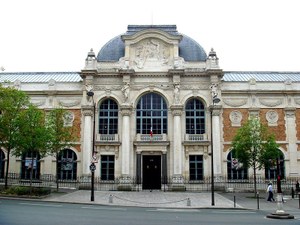What made the Gobelin family very wealthy however, was, scarlet dye. The first head of the firm was named Jehan (d. 1476) who discovered a peculiar kind of scarlet dyestuff and he expended so much money on his establishment that it was named by the common people la folie Gobelin. To the dye-works there was added in the 16th century a manufactory of tapestry. The family's wealth increased so rapidly that in the third or fourth generation some of them forsook their trade and purchased titles of nobility. The name of the Gobelins as dyers cannot be found later than the end of the 17th century.
In 1602, Henry IV of France rented factory space from the Gobelins for his Flemish tapestry makers on the current location of the Gobelins Manufactory adjoining the Bièvre river. In 1629 the sons, Charles de Comans and Raphaël de la Planche, took over their fathers' tapestry workshops and in 1633 Charles was the head of Gobelins manufactory. Their partnership ended around 1650 and the workshops were split into two. Tapestries from this early, Flemish, period are sometimes called pre-gobelins. In 1662, the works in the Faubourg Saint Marcel, with the adjoining grounds, were purchased by Jean-Baptiste Colbert on behalf of Louis XIV and transformed into a general upholstery manufactory, the Gobelins Manufactory.
Today the manufactory consists of a set of four irregular buildings dating to the seventeenth century, plus the building on the avenue des Gobelins built by Jean-Camille Formigé in 1912 after the 1871 fire. They contain Le Brun's residence and workshops that served as foundries for most of the bronze statues in the park of Versailles, as well as looms on which tapestries are woven following seventeenth century techniques.
The Gobelins still produces some limited amount of tapestries for the decoration of French governmental institutions, with contemporary subjects.



